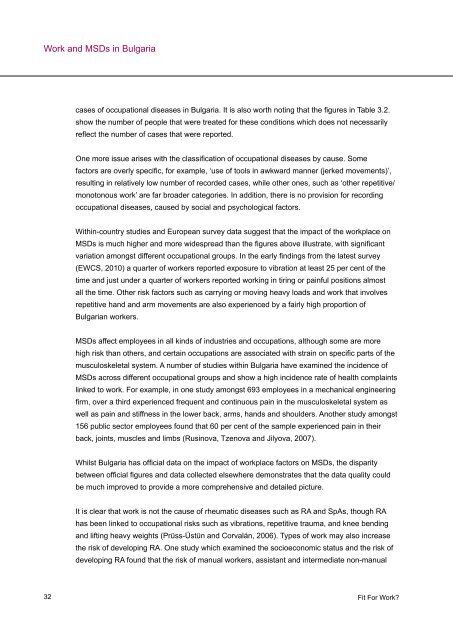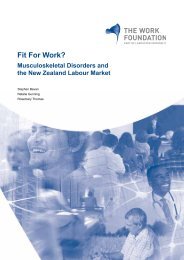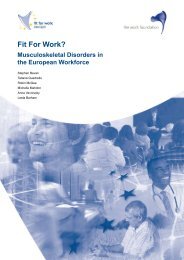FfW Bulgarian report (English language) - Fit for Work Europe
FfW Bulgarian report (English language) - Fit for Work Europe
FfW Bulgarian report (English language) - Fit for Work Europe
You also want an ePaper? Increase the reach of your titles
YUMPU automatically turns print PDFs into web optimized ePapers that Google loves.
<strong>Work</strong> and MSDs in Bulgaria<br />
32<br />
cases of occupational diseases in Bulgaria. It is also worth noting that the figures in Table 3.2.<br />
show the number of people that were treated <strong>for</strong> these conditions which does not necessarily<br />
reflect the number of cases that were <strong>report</strong>ed.<br />
One more issue arises with the classification of occupational diseases by cause. Some<br />
factors are overly specific, <strong>for</strong> example, ‘use of tools in awkward manner (jerked movements)’,<br />
resulting in relatively low number of recorded cases, while other ones, such as ‘other repetitive/<br />
monotonous work’ are far broader categories. In addition, there is no provision <strong>for</strong> recording<br />
occupational diseases, caused by social and psychological factors.<br />
Within-country studies and <strong>Europe</strong>an survey data suggest that the impact of the workplace on<br />
MSDs is much higher and more widespread than the figures above illustrate, with significant<br />
variation amongst different occupational groups. In the early findings from the latest survey<br />
(EWCS, 2010) a quarter of workers <strong>report</strong>ed exposure to vibration at least 25 per cent of the<br />
time and just under a quarter of workers <strong>report</strong>ed working in tiring or painful positions almost<br />
all the time. Other risk factors such as carrying or moving heavy loads and work that involves<br />
repetitive hand and arm movements are also experienced by a fairly high proportion of<br />
<strong>Bulgarian</strong> workers.<br />
MSDs affect employees in all kinds of industries and occupations, although some are more<br />
high risk than others, and certain occupations are associated with strain on specific parts of the<br />
musculoskeletal system. A number of studies within Bulgaria have examined the incidence of<br />
MSDs across different occupational groups and show a high incidence rate of health complaints<br />
linked to work. For example, in one study amongst 693 employees in a mechanical engineering<br />
firm, over a third experienced frequent and continuous pain in the musculoskeletal system as<br />
well as pain and stiffness in the lower back, arms, hands and shoulders. Another study amongst<br />
156 public sector employees found that 60 per cent of the sample experienced pain in their<br />
back, joints, muscles and limbs (Rusinova, Tzenova and Jilyova, 2007).<br />
Whilst Bulgaria has official data on the impact of workplace factors on MSDs, the disparity<br />
between official figures and data collected elsewhere demonstrates that the data quality could<br />
be much improved to provide a more comprehensive and detailed picture.<br />
It is clear that work is not the cause of rheumatic diseases such as RA and SpAs, though RA<br />
has been linked to occupational risks such as vibrations, repetitive trauma, and knee bending<br />
and lifting heavy weights (Prüss-Üstün and Corvalán, 2006). Types of work may also increase<br />
the risk of developing RA. One study which examined the socioeconomic status and the risk of<br />
developing RA found that the risk of manual workers, assistant and intermediate non-manual<br />
<strong>Fit</strong> For <strong>Work</strong>?







